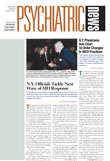Are there warning signs in very young children that point to the development of psychiatric disorders by age 10 or 1l? The answer is yes, according to a Dutch study reported in the September Journal of the American Academy of Child and Adolescent Psychiatry.
If a child is anxious, depressed, aggressive, defiant, overly active, or has a physical health problem at age 2 or 3, he or she may be at heightened risk of experiencing an anxiety disorder, depressive disorder, attention-deficit/hyperactivity disorder, or oppositional defiant disorder by age 10 or 11, the findings suggest.
Back in 1989 the study’s investigators—Hans Koot, Ph.D., a professor of developmental psychopathology at Erasmus University in Rotterdam, and Judi Mesman, Ph.D., a research psychologist at the same university—interviewed the parents of 420 2-year-old and 3-year-old children to learn about the children’s particular psychological characteristics and physical health, as well as about the parents’ parenting style and the children’s home environments.
In interviewing the parents, Koot and Mesman used a standardized instrument to assess behavioral/emotional problems in children of this age—the Child Behavior Checklist/2-3, which has been validated scientifically both in the Netherlands and the United States.
Then nine years later, that is, when the 420 children were 10 or 11 years old, Koot and Mesman interviewed parents of 332 of them to determine whether any of the children had anxiety disorders, mood disorders, or disruptive behavior disorders as defined in DSM-IV. At this point the researchers used a structured interview called the Diagnostic Interview Schedule for Children-Version 4–Parent Version, which had been translated into Dutch.
Seventy-four of the 332 youngsters (22 percent) met criteria for one or more of such disorders. This 22 percent was a bit higher, but not all that dissimilar from results found for preadolescents in other similar studies. What’s more, of the 22 percent, 12 percent met criteria for anxiety or mood disorders, and 13 percent met criteria for disruptive behavior disorders. The most prevalent diagnoses were specific phobia (9 percent), oppositional defiant disorder (6 percent), and attention-deficit/hyperactivity disorder–inattentive type (5 percent).
Koot and Mesman then attempted to determine whether the types of psychological difficulties experienced by the 74 10- and 11-year-old children at age 2 or 3 might have predicted the types of psychological difficulties that they later experienced at age 10 or 11. They did in fact find such a positive correlation.
Preschoolers with anxiety or mood problems had an almost threefold increased risk for similar problems several years later, and preschoolers with disruptive behavior had an almost five times higher risk for later similar problems. “These results confirm the considerable developmental stability of such problems even from a very young age,” the researchers state.
More surprisingly, the physical health of the 74 10- and 11-year-olds at ages 2 and 3 also turned out to be a strong predictor of their psychological difficulties at ages 10 and 11, Koot and Mesman discovered. And as the investigators note in their report, “The association between parent-reported early physical problems and later psychopathology may reflect a true association between early ill health and later psychopathology, or the report of these problems may be a marker for some other causal factor.”
Koot and Mesman also attempted to determine which factors early in the childhoods of the 74 10- and 11-year-old children with psychological difficulties might have significantly and independently predicted, from a statistical viewpoint, their experiencing such difficulties at ages 10 and 11.
They found that early affective, mood, or disruptive behavior problems were the answer. In other words, when such early problems were taken into consideration, most environmental factors, such as harsh parenting, negative maternal attitude, family psychopathology, maternal absence, and lower socioeconomic status, did not independently contribute to the prediction of preadolescent psychopathology. Only stressful life events remained an independent significant predictor of psychological difficulties at age 10 or 11.
In an interview with Psychiatric News Koot agreed that these results suggest that prevention efforts that target preadolescent psychopathology might be most cost-effective if primarily aimed at early childhood affective problems, mood problems, disruptive behavior, and physical health problems. He cautioned, however, that “this does not necessarily say how prevention efforts should address such early problems.”
For instance, he speculated that very early affective, mood, or disruptive behavior problems may be related to genes and biology. Then in that case, genetic and biological preventive efforts might be in order. But if ineffective parenting between birth and ages 2 and 3 are responsible for affective, mood, or disruptive problems that develop at those ages, then countering ineffective parenting during the first critical months of life would constitute an effective preventive strategy.
An abstract of the article, “Early Preschool Predictors of Preadolescent Internalizing and Externalizing DSM-IV Diagnoses,” is posted on the Web at www.jaacap.com under the September issue. ▪
